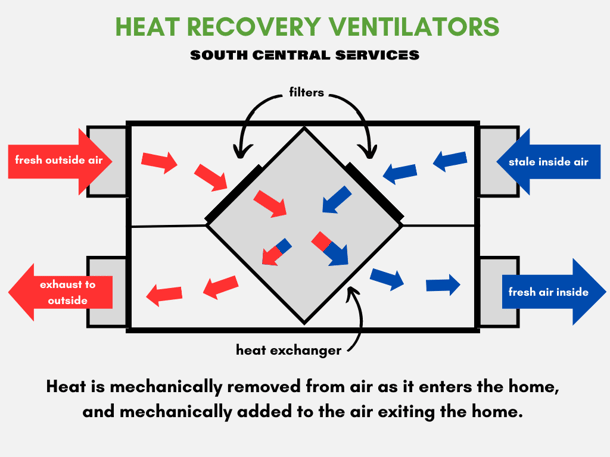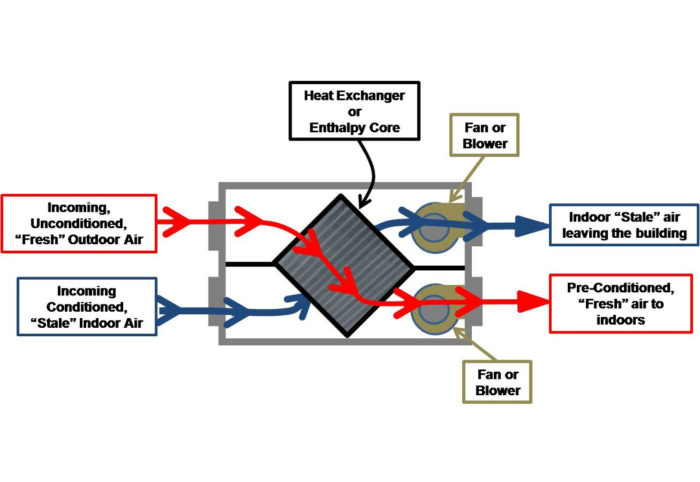Introducing the Trick Perks and Uses of Heat Recovery Ventilation in Sustainable Design
Heat Recovery Ventilation (HRV) systems play an important role in lasting style. They facilitate a continuous exchange of stagnant indoor air with fresh outdoor air, significantly enhancing indoor air top quality. In addition, HRVs add to energy efficiency by recovering warmth from exhausted air, which can decrease utility prices. Comprehending the complex advantages and applications of HRVs reveals their significance in contemporary design. What various other advantages do these systems offer in the quest of sustainability?
Comprehending Heat Recovery Ventilation Systems
Heat recovery ventilation (HRV) systems are made to boost indoor air top quality while decreasing power loss. These systems use a mechanical ventilation strategy to exchange stagnant interior air with fresh outdoor air, ensuring a continual supply of clean air. By recording heat from the exhaust air, HRVs prerequisite incoming air, lowering the demand on home heating and cooling systems. This process not just improves thermal comfort but likewise adds to energy performance in domestic and industrial buildings. Furthermore, HRV systems aid regulate humidity levels and lower interior pollutants, advertising a much healthier living setting. Their tactical execution is necessary for attaining lasting design goals, as they supply a balance between energy conservation and resident wellness.
How HRV Equipment Work
While several may know with ventilation systems, recognizing how warm healing ventilation (HRV) systems run is vital for appreciating their benefits. HRV systems work by trading stagnant indoor air with fresh outside air while transferring warmth in between both streams. This procedure happens in a warm exchanger, where heat from the outgoing air warms the inbound air throughout cooler months, decreasing energy loss. Conversely, in warmer months, the system can cool down inbound air utilizing the cooler outgoing air. HRVs are outfitted with followers to help with airflow and filters to eliminate particulates, making sure a constant, balanced air flow procedure. This ingenious design not just improves energy efficiency yet additionally adds to maintaining a comfy interior environment.
Enhancing Indoor Air Top Quality
Interior air high quality can significantly impact wellness and wellness, making effective ventilation important in modern-day homes. Heat Recovery Ventilation (HRV) systems play an essential duty in preserving interior air high quality by continually exchanging stagnant indoor air with fresh exterior air. This process not just decreases air-borne contaminants yet likewise minimizes moisture levels, which can cause mold development and respiratory issues. HRV systems filter incoming air, eliminating allergens and particulates, thereby giving a healthier living setting. Furthermore, these systems help get rid of odors and volatile organic compounds (VOCs) frequently located in home items. By ensuring a consistent circulation of tidy air, HRV systems add to a general enhanced interior environment, promoting convenience and health for occupants.
Energy Effectiveness and Price Savings
Energy effectiveness stands apart as a considerable benefit of Heat Recovery Ventilation (HRV) systems. By catching and recycling the heat from tired indoor air, HRVs minimize the energy required for home heating inbound fresh air, leading to minimized energy intake. This efficiency translates into reduced energy costs, supplying significant cost savings for home owners and businesses alike. Additionally, HRV systems commonly get power performance motivations and refunds, better enhancing their financial appeal. Over time, the initial investment in HRV innovation can lead to a favorable roi with reduced power expenses. The assimilation of HRV systems not just advertises lasting layout however also supplies a sensible solution for attaining long-lasting energy financial savings and monetary benefits.
Ecological Benefits of HRV

A wide range of environmental benefits emerges from the execution of Heat Recovery Ventilation (HRV) systems. By successfully transferring warmth from exhaust air to incoming fresh air, HRVs considerably lower the energy required for home heating and cooling down rooms. This energy efficiency converts to decrease greenhouse gas emissions, adding to a reduction in the overall carbon impact of structures. Furthermore, HRV systems improve interior air high quality by constantly circulating fresh air, therefore minimizing the concentration of indoor toxins and irritants. The decrease in energy consumption help in preserving all-natural resources, making HRVs a vital component of sustainable style. Overall, the ecological advantages of HRVs play an essential role in promoting a healthier earth and fostering environment-friendly building methods.
Versatile Applications in Modern Design
Heat recovery ventilation (HRV) systems are significantly being integrated right into both residential and industrial building projects. In residential setups, HRVs enhance indoor air top quality while making best use of energy effectiveness. In business rooms, these systems maximize air flow methods, demonstrating their convenience in modern architectural applications.
Residential Projects Combination
While modern architecture progressively emphasizes sustainability, the combination of heat recovery air flow systems in domestic jobs has become a functional option for improving interior air high quality and energy performance. These systems successfully transfer warmth from exhaust air to incoming fresh air, minimizing energy loss and reducing home heating or cooling down demands. In new builds and retrofits alike, heat healing ventilation can be perfectly integrated, giving home owners with a healthier living setting while reducing energy prices. In addition, with raising understanding of ecological effects, even more designers and building contractors are acknowledging the lasting advantages of these systems. Therefore, warmth recuperation air flow has become an essential component of lasting property style, showcasing adaptability and commitment to environment-friendly practices.
Commercial Rooms Optimization
As modern-day industrial spaces advance to satisfy the demands of sustainability and efficiency, the execution of warm recovery air flow systems becomes a key approach for maximizing interior environments. These systems promote the exchange of stagnant interior air with fresh outside air while redeeming warm power, substantially minimizing energy intake. This not only enhances comfort for occupants however also assists in lowering functional costs. Flexible applications can be observed in workplaces, retail areas, and schools, where air top quality and temperature control are paramount. Furthermore, incorporating heat healing air flow aligns with environment-friendly building accreditations, further promoting ecological responsibility. Eventually, taking on such systems in commercial architecture not just contributes to sustainability goals but additionally promotes healthier, much more effective spaces for customers.
Integrating HRV Into Sustainable Style Practices
Incorporating heat healing air flow (HRV) systems right into lasting layout techniques offers significant benefits in power efficiency and indoor air top quality. By making use of HRV, developers can develop cost-efficient services that not only reduce power intake however likewise the original source enhance the overall convenience of indoor environments. This placement with sustainability objectives settings HRV as a necessary component in modern building approaches.
Power Effectiveness Enhancement
By including warm healing ventilation (HRV) systems into lasting style methods, engineers and builders can considerably boost power effectiveness in modern constructions. HRV systems function by recording warm from outgoing stale air and transferring it to incoming fresh air, decreasing the energy needed for heating or cooling interior spaces. This procedure not only minimizes reliance on typical HVAC systems however also decreases overall power consumption. In enhancement, HRV systems can assist maintain a regular interior temperature, lowering peak energy needs. By integrating these systems, structures can attain significant decreases in utility expenses and carbon impacts, aligning with sustainability goals. Inevitably, HRV technology represents a practical solution for improving power efficiency in the developed setting, promoting helpful resources more liable resource use.
Indoor Air High Quality Renovation
How can warm recuperation ventilation (HRV) systems contribute to remarkable indoor air quality in modern-day buildings? HRV systems efficiently exchange stagnant indoor air with fresh outdoor air while recovering warmth power, lessening temperature level variations. This procedure lowers the focus of interior toxins, such as unpredictable natural substances (VOCs), irritants, and wetness, which can deteriorate air quality and effect owner health. By preserving suitable moisture degrees and ensuring a continuous supply of clean air, HRVs help produce a much healthier interior atmosphere. Additionally, these systems can be integrated into sustainable design practices, promoting power performance alongside boosted air top quality. HRV Heat Recovery Ventilation. Subsequently, HRV innovation plays an essential duty in progressing total owner convenience and wellness in contemporary architectural designs
Affordable Design Solutions

Often Asked Inquiries
What Upkeep Is Needed for Heat Recovery Ventilation Solutions?

Maintenance for heat healing ventilation systems commonly entails normal filter substitutes, cleaning of warmth exchangers, inspection of followers and ducts, and guaranteeing proper water drainage. These jobs help preserve performance and lengthen the system's life expectancy over time.
Can HRV Solutions Be Mounted in Existing Buildings?
Heat recovery ventilation systems can without a doubt be installed in existing buildings. HRV Heat Recovery Ventilation. Retrofitting calls for careful preparation and evaluation of the structure's format, guaranteeing compatibility this with present systems while optimizing power efficiency and indoor air high quality
Just How Do HRV Equipment Influence Noise Levels Inside Your Home?
HRV systems can affect interior sound levels by introducing sound from outside sources via ventilation. However, high-grade installations typically include sound-dampening attributes, lessening sound effect while supplying reliable air exchange and keeping convenience inside.
Exist Any Type Of Drawbacks to Utilizing HRV Solutions?
The drawbacks of using HRV systems include possible high first costs, maintenance difficulties, and the possibility of decreased indoor air quality if filters are not on a regular basis altered, which might result in issues with moisture degrees.
Just how Do I Select the Right HRV System for My Requirements?
Choosing the right heat recuperation air flow system includes assessing particular demands, such as developing dimension, climate, and energy effectiveness goals. In addition, reviewing system features, installation demands, and maintenance factors to consider is vital for peak performance and fulfillment.